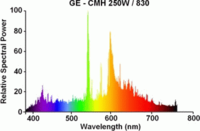
Photo from wikipedia
Abstract The present paper experimentally provides a quantitative comparison between the aerodynamic flow field at non-reaction conditions (cold flow) and the combustion and emission characteristics (hot conditions) of two swirl… Click to show full abstract
Abstract The present paper experimentally provides a quantitative comparison between the aerodynamic flow field at non-reaction conditions (cold flow) and the combustion and emission characteristics (hot conditions) of two swirl burners having the same swirl number of 0.55 but with two different configurations. The first burner features an annular outer swirler (swirl angle of 40°) and multiple central circular jets, leading to “low swirl combustion”, whereas the second burner has a blocked central passage and an outer swirler (swirl angle of 35°) resulting in “high swirl combustion”; featuring a central recirculation zone. The cold flow study is conducted using a calibrated five-hole probe while the combustion and emission characteristics are obtained via measurements of flame temperatures and the dry volumetric analysis of CO and NOx emissions. Each burner is coaxially mounted to a vertical cylindrical combustor; inside which a lean (equivalence ratio: ϕ = 0.75), pre-vaporized (preheated to a temperature of 523 K) partially premixed mixture of Jet A-1 fuel and air are admitted. The former low swirl combustion burner gives a bulk stable and uniform reaction zone (W-shape) close to the burner exit with a very slight lifting; confirming the concept of “stable lifting” while reducing the pressure drop across the burner exit and eliminating hot spots in the reaction zone. The high swirl combustion burner exhibits a strong central recirculation zone (better flame stability) that is surrounded by an outer V-shape reaction zone having comparatively higher peak levels of temperature, CO and NOx that would lead to greater liability of higher exhaust emission.
Journal Title: Energy
Year Published: 2021
Link to full text (if available)
Share on Social Media: Sign Up to like & get
recommendations!